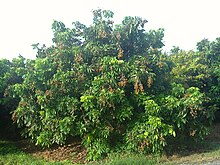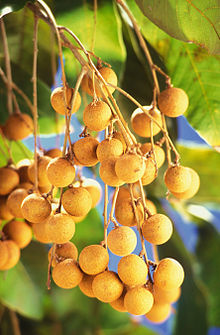Longan
| Longan Dimocarpus longan | |
|---|---|
 | |
 | |
| Longan fruit | |
| Conservation status | |
| Scientific classification | |
| Kingdom: | Plantae |
| (unranked): | Angiosperms |
| (unranked): | Eudicots |
| (unranked): | Rosids |
| Order: | Sapindales |
| Family: | Sapindaceae |
| Genus: | Dimocarpus |
| Species: | D. longan |
| Binomial name | |
| Dimocarpus longan Lour. | |
| Synonyms | |
| Euphoria longan Steud. | |
Dimocarpus longan, commonly known as the longan, is a tropical tree native to South and Southeast Asia, in the Indomalaya ecozone known for its edible fruit.
Vernacular names
The fruit is known as longan or longyan in English. It is also known as, in simplified Chinese: 龙眼; traditional Chinese: 龍眼; Mandarin Pinyin: lóngyǎn; Jyutping: lung ngaan; literally "dragon eye", in Lao: ລໍາໄຍ Lam Yai, in Vietnamese: Long Nhãn/Nhãn, in Malaysian: mata kucing, literally "cat's eye", in Indonesian: Kelengkeng, in Sinhala: Mora or Lengkeng, in Thai: ลำไย Lam Yai, in Filipino: Longan, in Bangladesh : Ashfol, Tamil: முதலிப் பழம் (Muthali Pazham)
Description
The Dimocarpus longan tree can grow up to 6 to 7 metres in height, and the plant is very sensitive to frost. Longan trees require sandy soil and temperatures that do not typically go below 4.5 degrees Celsius (40.1 degrees Fahrenheit). Longans and lychees bear fruit at around the same time of the year.
Culinary uses
The fruit is edible, extremely sweet, juicy and succulent in superior agricultural varieties, and apart from being eaten fresh, is also often used in East Asian soups, snacks, desserts, and sweet-and-sour foods, either fresh or dried, sometimes canned with syrup in supermarkets.
Dried longan, called guìyuán (桂圆) in Chinese, are often used in Chinese cuisine and Chinese sweet dessert soups. In Chinese food therapy and herbal medicine, it is believed to have an effect on relaxation. In contrast with the fresh fruit, which is juicy and white, the flesh of dried longans is dark brown to almost black. In Chinese medicine the longan, much like the lychee, is thought to give internal "heat" (上火).
Cultivation
Potassium chlorate has been found to cause the longan tree to blossom. However, this causes stress on the tree if it is used excessively, and eventually kills it.
See also
References
External links
Retrieved from : http://en.wikipedia.org/w/index.php?title=Longan&oldid=466051545
